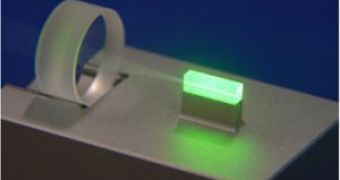Most of the problems related to lasers nowadays is the so-called photon noise, which determines fluctuations in the laser beam intensity, due to random quantum mechanics interactions, that ultimately reduces the sensitivity of the device. Physicists from the Planck Institute for Gravitational Physics (known as the Albert Einstein Institute) have succeeded in reducing the photon noise levels by over 90 percent, through a technique called light squeezing that can also be used in quantum key distribution, meaning that signals can be encrypted with keys generated by the quantum effects.
As most of you probably know, light is not emitted continuously, but in quantum packets of energy called photons. Furthermore, light sources cannot generate the same amount of photons at separate periods of time, even though the power supply is continuous, because photons are emitted randomly on the basis of a statistical formula. Thus, at one time, the laser system may emit just a few photons, while sometimes photons hit a given surface in bunches that arrive almost simultaneously. This variation in photon number, thus in light intensity, is known as photon noise.
Light squeezing is achieved by moving individual photons inside a laser beam, in order to obtain a more even photon distribution. By doing so, the quantum physics statistical nature is not violated, meaning that the photon emission process still occurs randomly, but they are bundled into pairs to ensure that they arrive in regular time intervals, effect widely known in the field of quantum physics as entanglement.
But why do we even need such accurate laser systems? Well, one application would be in gravitational wave detections. Such devices need extremely sensitive laser systems, in order to accurately measure variation in distances one thousand times smaller than the diameter of the atom nucleus. According to professor Roman Schnabel from the Leibniz University, light squeezing could also be used in optical data transmission, as it ensures a perfect encryption system and it does not interfere with the transmission result.
All laser systems in the gravitational wave detectors use infrared light. Schnabel explains how the light squeezing effect is obtained. Two separate laser beams are required, thus the team had to use double refraction crystals to make the system work, meaning the crystal had to refract optical light and infrared light as well. A green beam of light is used to polarise the crystal, determining the electrons in the atoms to oscillate with the same frequency as the light. Green light has wavelengths half of that of infrared light. As the electrons oscillate, they enable the crystal to retain part of the photons from the infrared beam light, thus when the infrared laser suffers a drop in brightness the beam is immediately supplemented with photon particles from the crystal.
However, the detection of the elusive gravitational waves is still to take place. Why is that? Because the force exerted on the two parallel mirrors is so weak that the interference pattern obtained is practically indistinguishable, producing difference between patterns of one billion times smaller than that of an atom, scale which is practically unreachable with the available technology, especially while taking into consideration photon noise. However, this may soon change, as light squeezing promises to produce interference patterns with very regular light intensity.

 14 DAY TRIAL //
14 DAY TRIAL //